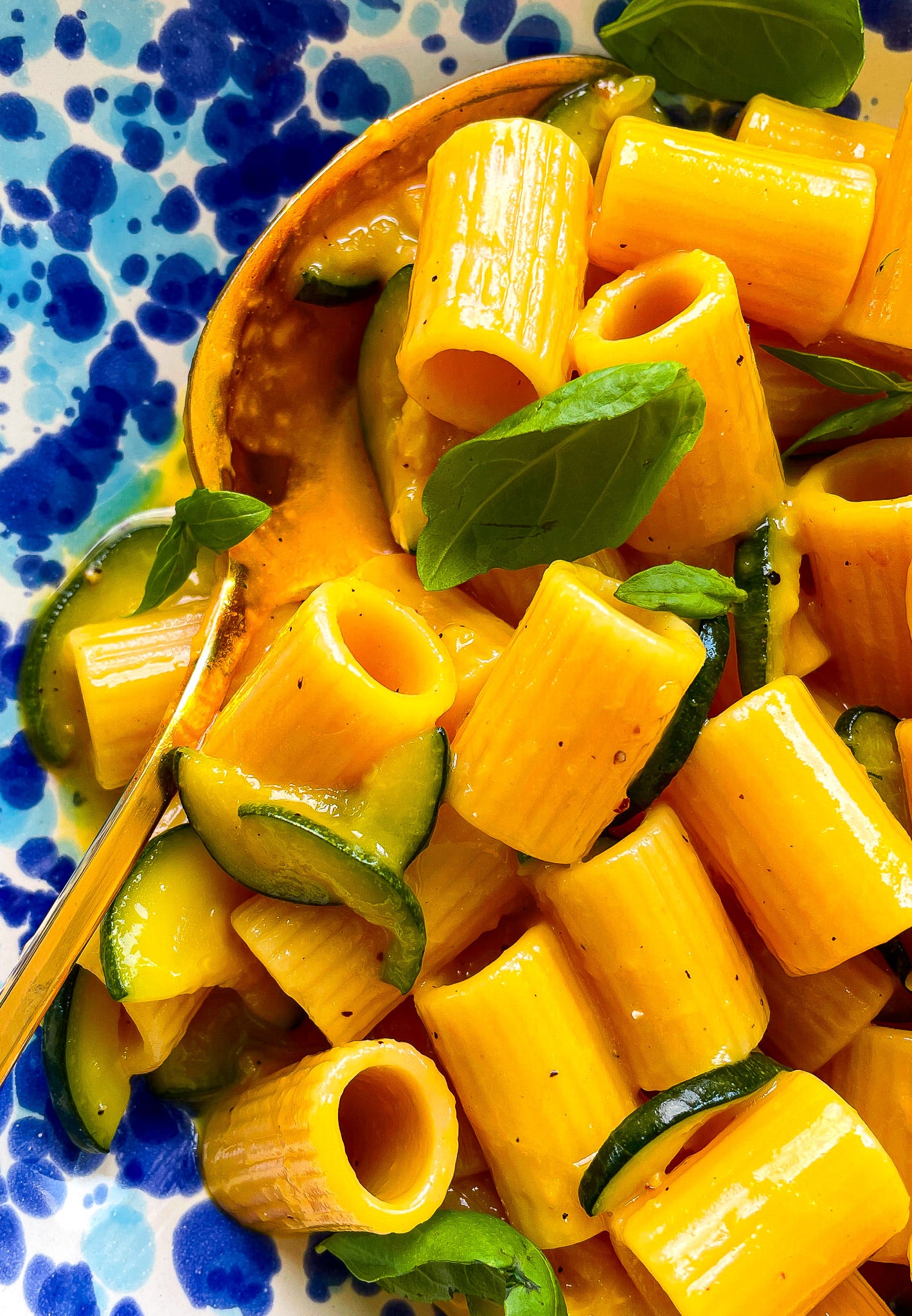Today I’m going to attempt the impossible: To convince you that yes, you should swap the salty, fatty, gloriously luxurious hunk of pork in your carbonara for…zucchini. I know. It sounds ridiculous. A kind of bland, often mushy, and overall meh vegetable that wouldn’t even make my top five summer produce list. But! But. Hear me out: If anything can make zucchini sing—and believe me, this sings—it’s a glossy, golden plate of carbonara.
Most of you know by now that I’m a bit of a purist. I am very protective of Italian tradition, even though I often decide to deviate from it in my recipes. So if you, too, are a purist and you’re currently yelling at your screen that THIS IS NOT CARBONARA! you would be correct. Carbonara is one of Rome’s Big Four pastas—joining cacio e pepe, gricia, and amatriciana—and what makes these dishes authentic are very particular ingredients and techniques. Traditionalists will tell you that none of the Big Four contain butter or cream or bacon or even Parmigiano-Reggiano. And carbonara, I’ve been taught, should be made with only the following five items: guanciale (cured pork cheek), Pecorino Romano, black pepper, eggs, and pasta.
That said, like all things Italian, there is a healthy amount of debate about what makes a classic carbonara. According to Katie Parla in her book Tasting Rome, for the amount of argument surrounding this dish, there is actually “no universal recipe for carbonara.” Guanciale is usually the pork product of choice, but pancetta is common, too; black pepper is pretty much non-negotiable but some modern chefs have started using white pepper instead; whole eggs are just as common as egg yolks; Pecorino Romano is a must, but sometimes it’s cut with Parmigiano; and the pasta shape can be spaghetti or rigatoni or something else entirely. Such variability has also led to further experimentation, bleeding into things like carbonara-inspired pizza toppings, ravioli fillings, and even cocktails.
Although many Romans have come to embrace these innovations, many more struggle to accept change when it comes to their most fiercely loved dishes. Which is especially interesting, considering carbonara is a relatively modern invention, first appearing in Rome in the mid-20th century. Even more surprising, popular lore points to World War II American and British soldiers as its masterminds, who, during Rome’s liberation, asked local chefs to mix their bacon rations and powdered eggs with pasta, resulting in carbonara’s first written reference in the newspaper La Stampa in the 1950s. Other legends trace its origins to charcoal-makers (“carbonari”; also often translated as coal miners) looking for a cheap and easily preserved meal, and even a Freemasons-esque Neapolitan (not Roman!) secret society from the 19th century called Carbonari. All myths, perhaps, but a good reminder that even the most authentic recipes stem from adaptation and experimentation, and perhaps we should not be so afraid to tinker and turn them into something a little new.
Which brings us to today’s zucchini carbonara, or carbonara di zucchine. I first spotted a version of this dish in fellow Substacker and my good friend
’s newest cookbook, Portico: Cooking and Feasting in Rome’s Jewish Kitchen (if you don’t already have this book, I can’t recommend it enough!). Classic Roman dishes like carbonara have always been tricky for us kosher-abiding, pork-abstaining Jews, and so the Jews of Rome made use of seasonal vegetables instead of the typical meat. But what was first introduced as a dietary necessity has now become a beloved summer variation, a much lighter version of a typically very heavy dish. Better yet, since we’re already throwing guanciale out the window, other changes—infusing the cooking oil with a clove of garlic; using a combination of Pecorino and Parmigiano; adding a flourish of basil—feel far less blasphemous. You could even take this a step further and swap the zucchini for mushrooms in the fall, and artichokes and/or peas in the spring (seafood carbonara, or carbonara di mare, is also an Italian summer favorite).This is not my first carbonara-adjacent recipe, but it is my easiest. Instead of using a combination of whole eggs and egg yolks, as I’ve done in the past, here I’m going all-in on yolks alone. Not only does this make for a beautiful color, but also a more easily emulsified sauce that requires little to no thickening. Better yet, said sauce stayed saucy long after I served it—no clumping or scrambling whatsoever—even post-refrigeration (never have I enjoyed cold carbonara more). And the often-mediocre zucchini? A wonderfully tender, slightly sweet harmony to all that salt and fat, putting this dish firmly at the top of my summer pasta playlist.
Zucchini Carbonara (Carbonara di Zucchine) For Two
Serves 2






